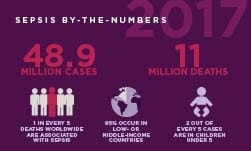
1/16/2020
PITTSBURGH – Twice as many people as previously believed are dying of sepsis worldwide, according to an analysis published today in
The Lancet and announced at the Critical Care Reviews annual meeting in Belfast. Among them are a disproportionately high number of children in poor areas.
Led by researchers at the
University of Pittsburgh and
University of Washington schools of medicine, the study revealed 48.9 million global cases of sepsis in 2017 and 11 million deaths, representing 1 in 5 deaths worldwide.
Sepsis occurs when a person’s organs cease to function properly as the result of an out-of-control immune response to infection. Even if sepsis doesn’t kill its victims, it can create
lifelong disabilities in survivors.
The large majority of sepsis cases — 85% in 2017 — occurred in low- or middle-income countries. The highest burden was found in sub-Saharan Africa, the South Pacific islands near Australia, and South, East and Southeast Asia. Sepsis incidence was higher among females than males. By age, the incidence of sepsis peaks in early childhood, with more than 40% of all cases occurring in children under 5.

“I’ve worked in rural Uganda, and sepsis is what we saw every single day. Watching a baby die of a disease that could have been prevented with basic public health measures really sticks with you,” said lead author Kristina E. Rudd, M.D., M.P.H., assistant professor in
Pitt’s Department of Critical Care Medicine. “I want to contribute to solving this tragedy, so I participate in research on sepsis. However, how can we know if we’re making progress if we don’t even know the size of the problem? If you look at any top 10 list of deaths globally, sepsis is not listed because it hasn’t been counted.”

For their analysis, Rudd and colleagues leveraged the
Global Burden of Disease Study, a comprehensive epidemiological analysis coordinated by the
Institute for Health Metrics and Evaluation (IHME) at the University of Washington School of Medicine. The
GBD 2017 Study currently reports on 282 primary causes of death not including sepsis, which is considered an intermediate cause of death. A primary cause of death is the underlying condition (e.g. cancer), which leads to the intermediate cause (sepsis) that ultimately results in death.
Previous global estimates for sepsis were limited as they relied upon hospital databases from a select group of middle- and high-income countries. The previous estimates overlooked the substantial burden of sepsis that occurs outside of the hospital, especially in low-income countries. Today’s study findings are unprecedented as they represent mortality both in and out of the hospital.

“We are alarmed to find sepsis deaths are much higher than previously estimated, especially as the condition is both preventable and treatable,” said senior author Mohsen Naghavi, M.D., Ph.D., M.P.H., professor of
health metrics sciences at IHME at the University of Washington School of Medicine. “We need renewed focus on sepsis prevention among newborns and on tackling antimicrobial resistance, an important driver of the condition.”
The study authors analyzed annual sepsis incidence and mortality trends from 1990 through 2017 and found rates are improving. In 1990, there were an estimated 60.2 million sepsis cases and 15.7 million deaths; by 2017, incidence had dropped by 19% to 48.9 million cases and deaths by 30% to 11.0 million.
The most common underlying cause of sepsis-related death in both 1990 and 2017 was lower respiratory infection.
“So what is the solution? Well, to start with it’s basic public health infrastructure. Vaccines, making sure everyone has access to a toilet and clean drinking water, adequate nutrition for children and maternal health care would address a lot of these cases,” said Rudd, who also is a
UPMC critical care physician. “But sepsis is still a problem here in the U.S., where it is the No. 1 killer of hospital patients. Everyone can reduce their odds of developing it by getting the flu shot, and the pneumonia vaccine when appropriate. Beyond that, we need to do a better job preventing hospital-acquired infections and chronic diseases, like diabetes, that make people more susceptible to infections.
“Finally, for people in high-income countries who want to help reduce the rates of sepsis in low-income areas, we need to support research into treatments and advocate to our elected officials for the importance of supporting sepsis prevention and control efforts in low-income communities,” Rudd said.
Additional authors on this research are Sarah Charlotte Johnson, M.Sc., Kareha M. Agesa, B.A., Katya Anne Shackelford, B.A., Derrick Tsoi, B.S., Danny V. Colombara, Ph.D., all of the IHME; Daniel Rhodes Kievlan, M.D., Christopher W. Seymour, M.D., Derek C. Angus, M.D., all of Pitt; Niranjan Kissoon, M.D., of the University of British Columbia; Simon Finfer, M.D., of the University of New South Wales; Carolin Fleischmann-Struzek, M.D., of Friedrich Schiller University Jena in Germany; Kevin S. Ikuta, M.D., Simon I. Hay, F.Med.Sci., Rafael Lozano, M.D., and Christopher J.L. Murray, D.Phil., all of the IHME and University of Washington; Flavia R. Machado, Ph.D., of the Federal University of São Paulo; Konrad K. Reinhart, M.D., of Friedrich Schiller University Jena and Charité University Medical Center Berlin, both in Germany; Kathryn Rowan, Ph.D., of the Intensive Care National Audit & Research Centre and the London School of Hygiene & Tropical Medicine, both in the U.K.; R. Scott Watson, M.D., of the University of Washington and Seattle Children’s Hospital; T. Eoin West, M.D., of the University of Washington; Fatima Marinho, M.D., of the University of São Paulo; and Alan D. Lopez, Ph.D., of the IHME and the University of Melbourne in Australia.
MULTIMEDIA INFO: (click images for high-res version)
TOP: (Credit: UPMC)
CAPTION: Kristina E. Rudd, M.D., M.P.H., assistant professor, University of Pittsburgh Department of Critical Care Medicine; UPMC critical care physician.
MIDDLE: (Credit: Larry Hruska/UPMC)
CAPTION: This infographic presents the results of a new study in The Lancet finding that sepsis incidence and deaths are double the previously accepted estimate.
BOTTOM: (Credit: University of Washington)
CAPTION: Mohsen Naghavi, M.D., Ph.D., M.P.H., professor of health metrics sciences at IHME at the University of Washington School of Medicine.

 “I’ve worked in rural Uganda, and sepsis is what we saw every single day. Watching a baby die of a disease that could have been prevented with basic public health measures really sticks with you,” said lead author Kristina E. Rudd, M.D., M.P.H., assistant professor in Pitt’s Department of Critical Care Medicine. “I want to contribute to solving this tragedy, so I participate in research on sepsis. However, how can we know if we’re making progress if we don’t even know the size of the problem? If you look at any top 10 list of deaths globally, sepsis is not listed because it hasn’t been counted.”
“I’ve worked in rural Uganda, and sepsis is what we saw every single day. Watching a baby die of a disease that could have been prevented with basic public health measures really sticks with you,” said lead author Kristina E. Rudd, M.D., M.P.H., assistant professor in Pitt’s Department of Critical Care Medicine. “I want to contribute to solving this tragedy, so I participate in research on sepsis. However, how can we know if we’re making progress if we don’t even know the size of the problem? If you look at any top 10 list of deaths globally, sepsis is not listed because it hasn’t been counted.” For their analysis, Rudd and colleagues leveraged the Global Burden of Disease Study, a comprehensive epidemiological analysis coordinated by the Institute for Health Metrics and Evaluation (IHME) at the University of Washington School of Medicine. The GBD 2017 Study currently reports on 282 primary causes of death not including sepsis, which is considered an intermediate cause of death. A primary cause of death is the underlying condition (e.g. cancer), which leads to the intermediate cause (sepsis) that ultimately results in death.
For their analysis, Rudd and colleagues leveraged the Global Burden of Disease Study, a comprehensive epidemiological analysis coordinated by the Institute for Health Metrics and Evaluation (IHME) at the University of Washington School of Medicine. The GBD 2017 Study currently reports on 282 primary causes of death not including sepsis, which is considered an intermediate cause of death. A primary cause of death is the underlying condition (e.g. cancer), which leads to the intermediate cause (sepsis) that ultimately results in death.  “We are alarmed to find sepsis deaths are much higher than previously estimated, especially as the condition is both preventable and treatable,” said senior author Mohsen Naghavi, M.D., Ph.D., M.P.H., professor of health metrics sciences at IHME at the University of Washington School of Medicine. “We need renewed focus on sepsis prevention among newborns and on tackling antimicrobial resistance, an important driver of the condition.”
“We are alarmed to find sepsis deaths are much higher than previously estimated, especially as the condition is both preventable and treatable,” said senior author Mohsen Naghavi, M.D., Ph.D., M.P.H., professor of health metrics sciences at IHME at the University of Washington School of Medicine. “We need renewed focus on sepsis prevention among newborns and on tackling antimicrobial resistance, an important driver of the condition.”















